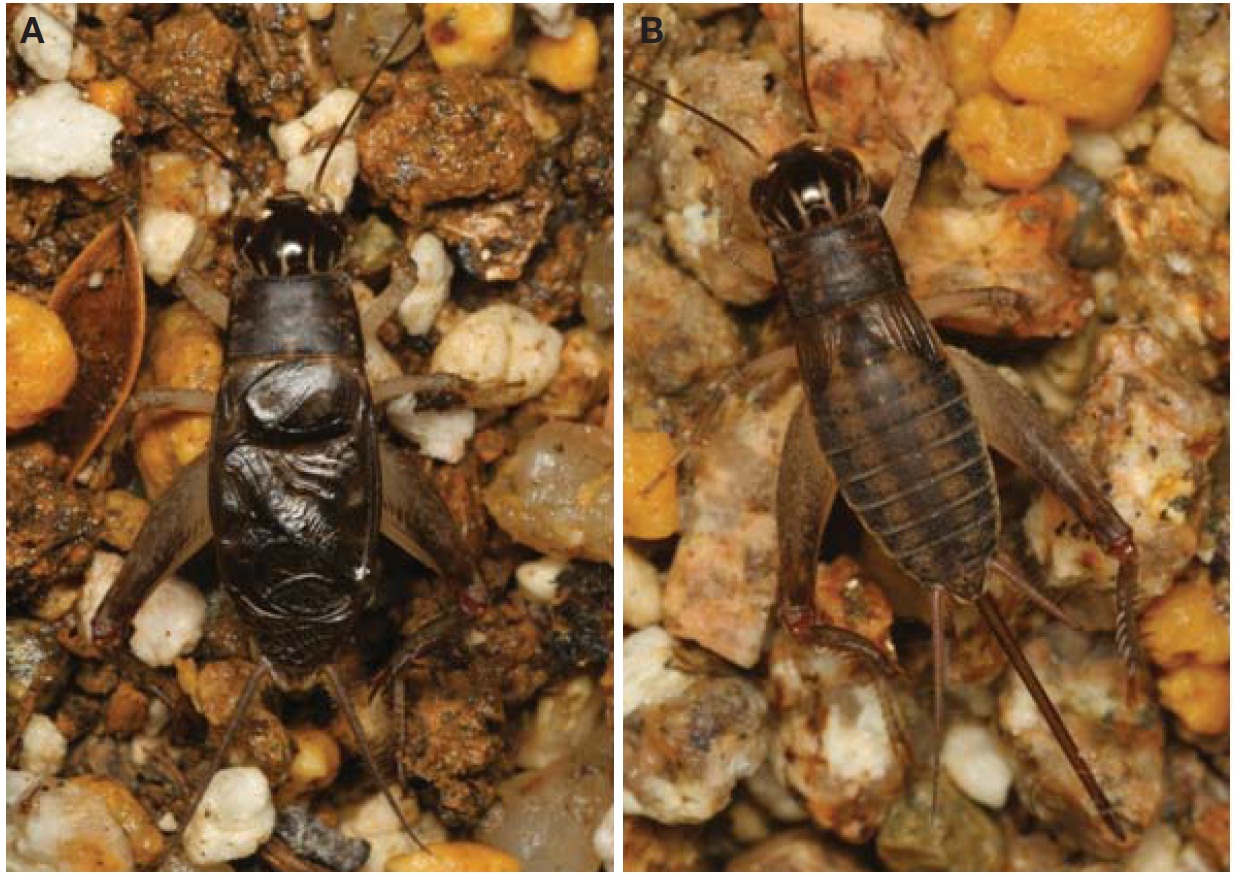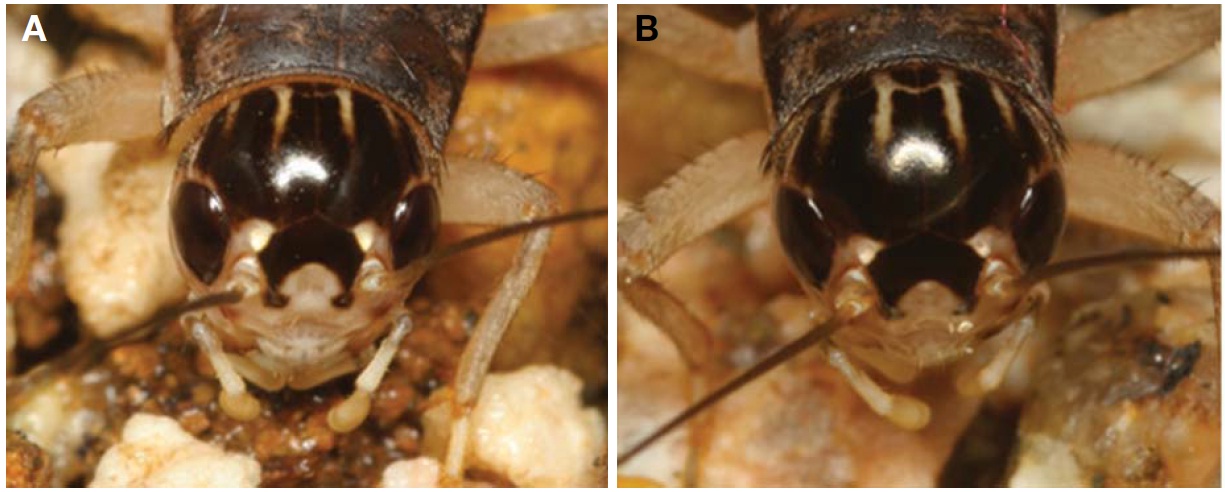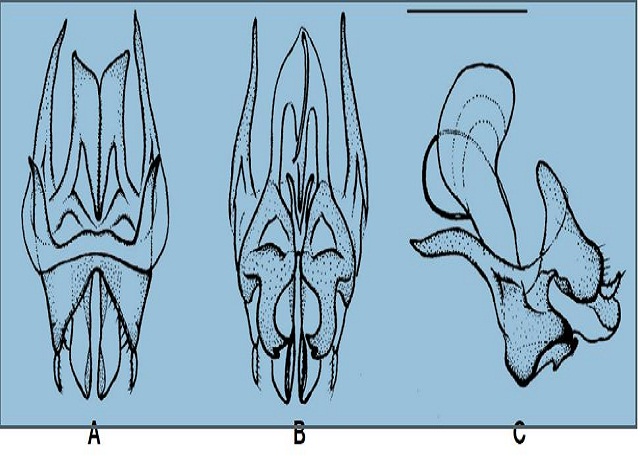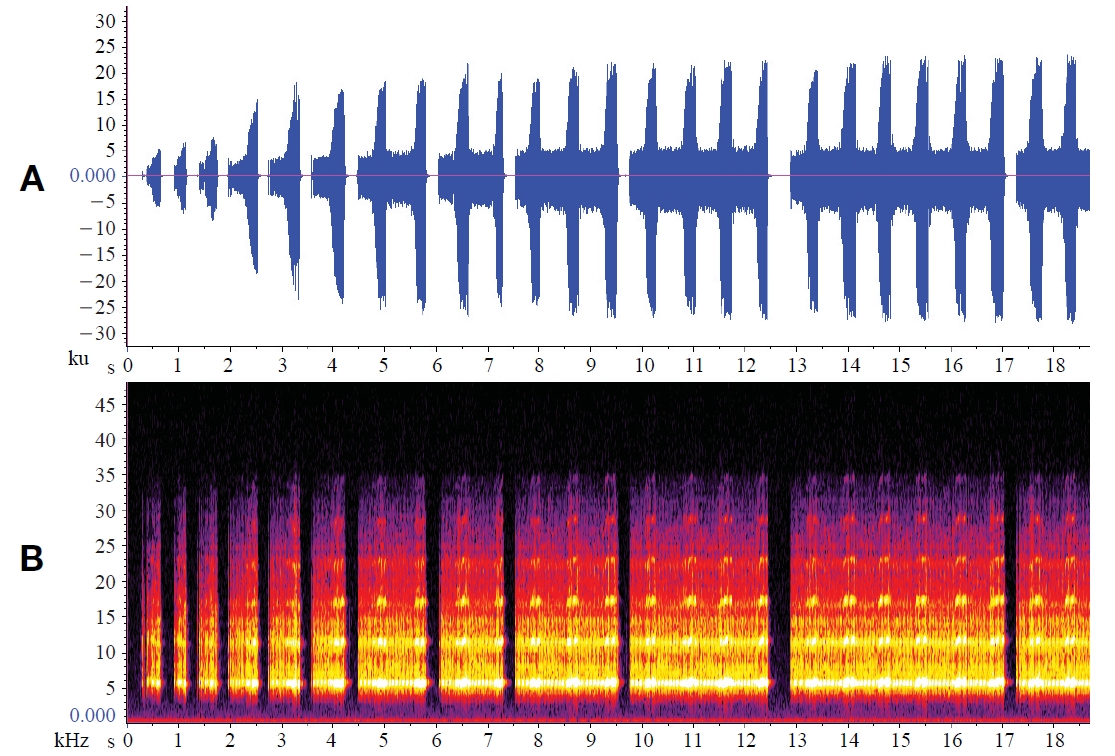



The field-cricket Turanogryllus eous Bey-Bienko, 1956 and its genus Turanogryllus Tarbinsky, 1940 were recorded for the first time from Chungcheongbuk-do province in Korea to carry out the project ‘The sound guides to Korean animals.’ Depending on the discovery of the cricket, its distributional ranges are more widened towards East Asia to the Korean peninsula from China mainland, the Turanogryllus was 10th to known Gryllinae genera in Korea. Description, photos of habitus, figure of male genitalia, oscillogram and spectrogram for the calling sound are provided for aid identification. Voucher specimens are deposited in the collection of National Institute of Biological Resources, Incheon, Korea.
One of the field-cricket genus
Diagnostic characters of the genus
To carry out the project ‘The sound guides to Korean ani-mals’ that was designed in 2010, I have been focusing on listening to cricket sounds in field survey. In the year 2010, during the course of the project, although unfamiliar yet very distinctive cricket’s calling sound was heard from Chungju City province. By tracing the sound only one male living specimen was captured, by short period rearing in the acous-tic laboratory and the sound was recorded in good quality (hear Kim, 2011). Second year in 2011, my colleague Mr. Sung Ki-Soo informed me that he had found a habitat of the field-cricket from the Jecheon City province near Chungju City. The collecting was successful for more confirmation.
Based on the microscopic observation of the specimens and morphological comparison from the earlier literatures, the field-cricket was identified to be ‘
Depending on the discovery of the field-cricket, its distri-butional ranges are now more widened towards East Asia to the Korean peninsula. The species and the genus are both newly recognized in Korean fauna. All voucher specimens are deposited in the dry collections of the National Institute of Biological Resources. Sound recording was accomplished by using the digital recorder (PCM D-50; SONY, Tokyo, Japan), the oscillogram and spectrogram are drawn by Raven Pro 1.3 (Cornell Lab of Ornithology). Terminology for des-cription refers to Randell (1964), Otte and Alexander (1983).
Order Orthoptera Olivier, 1789
Family Gryllidae Laicharting, 1781
Subfamily Gryllinae Laicharting, 1781
Genus Turanogryllus Tarbinsky, 1940
Type species: Gryllus lateralis Fieber, 1853
1*Turanogryllus eous Bey-Bienko, 1956 (Figs. 1-4)
of the Russian Academy of Sciences, St. Petersburg, Ru-ssia.
Material examined (12 specimens). Korea: Chungcheong-buk-do: 1♂ Chungju City, Gageum-myeon, Chungju Expres-sway Resting Place (a down line), 25 Aug 2010, Kim TW; 6♂5♀, Jecheon City, Cheongpung-myeon, Dan-ri, 4 Sep 2011, Sung KS.
Description. General: Body coloration brownish dark black, ventral parts and appendages more bright creamy yellow. Male body fusiform, with well developed wide tegmina that cover the whole abdomen; female body cylindrical, with short small tegmina that just cover to only the basal second abdominal tergites.
Male (Fig. 1A). Head (Fig. 2A): Roundly globular, weakly wider than the anterior margin of pronotum and the occiput with six bright longitudinal strips posteriorly. Vertex dark black colored with fine ecdysis ‘Y’ line; distance between the antennal sockets as wide as the greatest horizontal dia-meter of an eye. Lower margin of the antennal socket slightly
located higher than the lower margin of an eye. Median ocel-lus surrounded by the bright color region. Lateral ocelli also brightly encircled. Clypeal suture sinuately transverse in the mid toward above. Mouth parts and palpi clearly bright cream in color. Antennal scape as long as the width, without projec-tion.
Thorax: Pronotum 1.8 times wider than the length in dorsal view, its longitudinal length shorter than the fore femur; anterior margin smoothly concave; posterior margin trun-cated and wider than the anterior margin. Along both the margins with dense bristles, setose. Dorsal surface with a pair of black crescent-shaped markings. Lateral lobe of pro-notum as deep as the width and its lower half area clearly bright; lower anterior margin rather angularly round; lower hind margin widely round, shorter than the lower anterior margin. Mesosternum forms a pair of lobes posteriorly; meta-sternum not divided.
Wings: Tegmina macropterous, covers the abdominal end and wider than the posterior margin of pronotum; harp veins three or four, sinuated; chordal veins three; mirror area divid-ed, 1.5 times wider than the length; apical area well netted, 0.8 times shorter than the mirror area; lateral field deeper than the lateral lobe of pronotum, with seven or eight longi-tudinal veins; upper half area is darkish in color, lower one is bright creamy yellow in color. Hind wings degenerated to small plume-shaped.
Legs: Fore tibia with oval-shaped outer tympanum, 2.5 times longer than the width; inner tympanum hardly discernable, not distinguished; ventral apical spurs three. Middle tibia with two pairs of apical spurs, among them the outer posterior one shortest. Hind femur 2.5 times longer than the middle femur. Hind tibia with seven pairs of dorsal spines on both the sides, except for the two pairs of apical spurs; largest inner apical spur 0.4 times shorter than the basitarsus. Hind basitarsus two times longer than the combining length of the remaining two apical tarsomeres; dorsal spinules inner one five, outer one seven; inner apical spur 0.7 times shorter than the length of last tarsomere. All tarsomeres with numerous ventral bristles.
Abdomen: Cercus 0.8 times shorter than the hind femur. Subgenital plate widely rounded and upwardly recurved; hind margin with a V-shaped notch in mid, it forms a pair of lobes. Epiproct triangular, with a median longitudinal fur-row; lateral margins sinuated near the base of both the sides; apex narrowly truncated, beak-shaped. Dorsal lobes of ecto-parameres slightly visible, main genitalia hidden upon sub-genital plate.
Genitalia (Fig. 3): Epiphallus with a deeply emarginated posterior margin, which penetrated into two thirds of the entire length of the epiphallus; lateral lobes with short styli at their posterior apices. Ectoparameres divided apically into dorsal and ventral lobes; dorsal lobe lamelliform, weakly recurved in its posterior half, inner ventral margin serrulated; ventral lobe digitiform, sigmoidally curved, its apex divided into three tooth-like small lobes; basal median corners of the dorsal lobe, connects with the semicircular sclerotic arch.
Endoparameres with an expanded parameral muscle insertion at its base. Virga simply broad in its lateral view, apically short and unmodified. Rami divided at their dorsal ends, into a long dorsal process and a short ventral process. Ventral process associated with the base of the ectoparamere.
Female (Figs. 1B, 2B): Size and general appearance similar to the male, but tegmina remarkably shorter, thus the abdo-minal dorsal parts almost visible. Tegmina as long as, or sli-ghtly shorter than the longitudinal length of the pronotum, which not overlapped on the dorsum of the abdomen; inner margin oblique outwards and the tegminal apex angularly rounded; lateral field as deep as lateral lobe of pronotum, with five longitudinal veins. Subgenital plate trapezoidal, simply smaller than in the male, 1.8 times wider than the length; posterior margin narrower, U-shaped. Ovipositor straight needle-shaped, subapically swollen and slightly longer than the hind femur; apex sharply pointed, without serration.
Measurements (dry specimens in mm). Lengths of body ♂ 12.9-14.2, ♀ 12.5-15.8; pronotum ♂ 2.9-3.1, ♀ 2.9-3.3; tegmen ♂ 9.1-10.2, ♀ 2.0-3.0; hind femur ♂ 8.8-9.7, ♀ 9.6-10.9, ovipositor ♀ 11.0-12.8.
Calling sound (Fig. 4). Males are acoustically active both day and night. They stay in the cavity under rocks, or hide within the grass vegetation. Calling sound consists of a series of song phrases with an undulating 1-9 pitches that are based on each time of interlude for 0.6-0.8 s and their interval time was 0.2-0.35 s at 28℃ condition. Each syllable lasted to about 0.01 seconds during the interludes and 0.02-0.025 s during the each pitch. The dominant frequency spectrum was 5-16 KHz.
Distribution. Korea (new record) and China.
Remarks. Genitalic description of the type species
Korean name: 1*각시귀뚜라미 (신칭)



